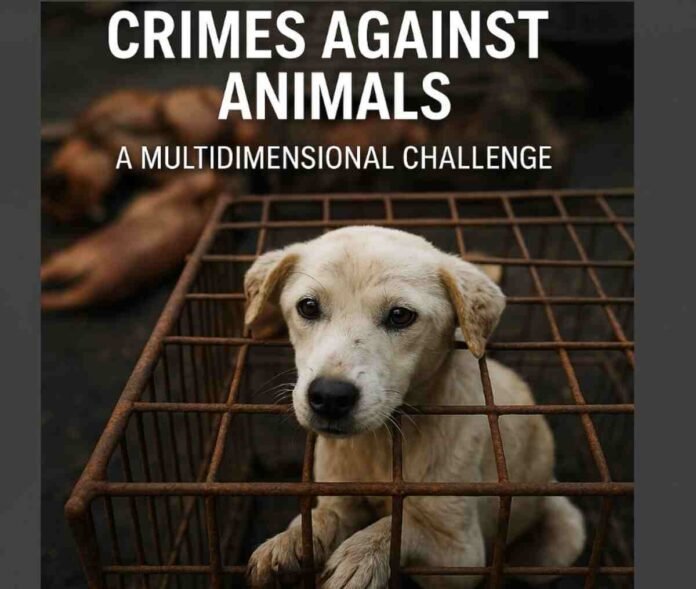By ADV. Vaishali Waghmare
Student, Bhagubai Changu Thakur College of Law, New Panvel
Abstract
Crimes against animals encompass acts of cruelty, exploitation, and neglect inflicted across domestic, wild, and farmed species. Rooted in a complex interplay of cultural, economic, psychological, and legal factors, these crimes often go underreported and underpunished. This paper explores the causes behind animal cruelty, highlights the gaps in legal frameworks and enforcement, and advocates for comprehensive strategies to cultivate compassion and accountability in society.
Keywords
Animal cruelty, legal protection, human-animal conflict, psychological factors, wildlife exploitation, animal welfare laws.
Introduction
Animals have historically been integral to human life, yet cruelty towards them remains a persistent societal issue. Whether domestic pets, strays, farm animals, or wildlife, countless creatures suffer abuse and neglect worldwide. Understanding the root causes behind crimes against animals is crucial to framing effective solutions that protect their rights and well-being.
- Causes of Crimes against Animals
1.1 Lack of Awareness and Education
Ignorance about animal sentience and rights often leads to neglect or mistreatment. Without humane education programs in schools and communities, empathy toward animals is rarely cultivated.
1.2 Commercial Exploitation
From poaching and illegal wildlife trade to exploitative entertainment and factory farming, the commercial use of animals frequently results in severe cruelty and suffering.
1.3 Human-Wildlife Conflict
Urbanization and habitat destruction push wild animals into human territories, leading to conflict. Often, these encounters end in violence against the animals involved.
1.4 Weak Law Enforcement
Although laws like the Prevention of Cruelty to Animals Act, 1960 exist, poor enforcement and minimal penalties fail to deter offenders, allowing cruelty to continue largely unchecked.
1.5 Psychological and Behavioral Factors
Animal cruelty is often linked to psychological disorders, including psychopathy and violent tendencies. Studies reveal a strong connection between early animal abuse and later crimes against humans.
1.6 Cultural and Traditional Practices
Cultural traditions involving animal sacrifice or blood sports often perpetuate cruelty under the guise of ritual or entertainment, challenging efforts at reform.
1.7 Neglect and Abandonment
Negligence in providing basic care, often due to irresponsibility or financial hardship, is a major contributor to animal suffering, particularly among domesticated animals.
1.8 Cruel Practices in Animal Husbandry
Mass farming operations prioritize efficiency and profit, frequently at the expense of animal welfare, leading to widespread inhumane treatment.
1.9 Influence of Social Media
The pursuit of viral fame has led some individuals to post videos depicting animal cruelty, normalizing such behavior among online audiences.
1.10 Economic Hardships
In economically disadvantaged areas, animals are often seen as expendable property. The lack of veterinary care, shelters, and welfare programs further fuels neglect and exploitation.
- Recommendations and Way Forward
- Strengthen Legislation: Updating and tightening animal welfare laws with harsher penalties for offenders.
- Increase Enforcement: Training and equipping law enforcement agencies to handle animal cruelty cases seriously.
- Promote Humane Education: Integrating compassion for animals into school curricula and community outreach.
- Support Rehabilitation Programs: Providing support for rescue operations, shelters, and animal welfare organizations.
- Encourage Public Awareness: Utilizing media campaigns to foster respect for animal life and discourage harmful traditions and trends.
Conclusion
Crimes against animals reflect broader societal issues involving empathy, ethics, and justice. Addressing these crimes demands a holistic approach combining legal reforms, educational initiatives, economic support, and a cultural shift towards valuing animal life. Building a society that respects animals is a vital step toward fostering greater humanity as a whole.
References
- Ascione, F. R. (1998). Animal Abuse and Youth Violence. Juvenile Justice Bulletin, U.S. Department of Justice.
- Bekoff, M. (2007). The Emotional Lives of Animals: A Leading Scientist Explores Animal Joy, Sorrow, and Empathy – and Why They Matter. New World Library.
- Flynn, C. P. (2000). Why Family Professionals Can No Longer Ignore Violence Toward Animals. Family Relations, 49(1), 87–95.
- Herzog, H. (2010). Some We Love, Some We Hate, Some We Eat: Why It’s So Hard to Think Straight About Animals.
- Lockwood, R., & Ascione, F. R. (1998). Cruelty to Animals and Interpersonal Violence: Readings in Research and Application. Purdue University Press.
- Nandimath, O. V. (2009). Enforcing Animal Welfare Laws in India: A Critical Analysis. Journal of Law and Policy, 17(2), 271–300.
- Prevention of Cruelty to Animals Act, 1960 (India).
- Sharma, N. (2015). Wildlife Crime in India: A Critical Evaluation of Legal Mechanisms. International Journal of Research and Analysis, 2(3), 15–23.
- World Animal Protection. (2020). Animal Protection Index: India Country Report. Retrieved from https://api.worldanimalprotection.org/country/india
Author’s Declaration
I affirm that this article represents my own original scholarly work. Any use of external sources has been appropriately cited.
Name: ADV. Vaishali Waghmare
Student: Bhagubai Changu Thakur College of Law, New Panvel
About the Author
Advocate Vaishali Waghmare is currently pursuing her legal studies at Bhagubai Changu Thakur College of Law, New Panvel. Her academic interests include animal welfare law, environmental justice, and human rights. Driven by a deep passion for advocating on behalf of the voiceless, she aspires to contribute to legal reforms that promote compassion, ethical treatment, and stronger protections for animals. This paper reflects her commitment to raising awareness about crimes against animals and fostering a more humane society


